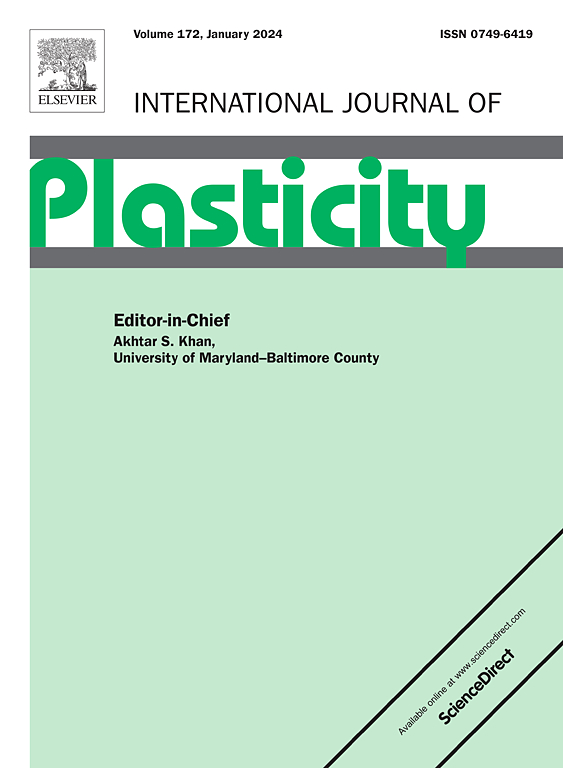具有中高层错能的化学复杂合金中平衡强度和延性的有希望的途径
IF 9.4
1区 材料科学
Q1 ENGINEERING, MECHANICAL
引用次数: 0
摘要
新兴的具有中高层错能(sfe)的化学复杂合金(CCAs)为先进材料提供了巨大的潜力,但实现强度和延性之间的平衡仍然具有挑战性。本研究探讨了Al8.3Co16.7Cr13.3Fe16.7Ni41.7V3.3 CCAs中部分再结晶的策略控制,以设计具有不均匀分布L12纳米沉淀物的微米级非均相结构。优化后的显微组织包括具有高角度晶界的精细再结晶区(HAGBs)、具有低角度晶界的粗未再结晶区(LAGBs)以及两种晶界类型共存的富含变形缺陷的过渡区(DDRT)。这种结构可以实现协同强化机制,包括晶界强化、沉淀强化、位错强化和异质变形诱导(HDI)强化,从而产生高达1623 MPa的特殊屈服强度。在塑性变形过程中,位错的堆积和积累与纳米沉淀和gb的相互作用平衡了剪切带扩展引起的应变软化,导致相对较低但稳定的加工硬化速率(whr)。随着变形的进行,越来越复杂的相互作用进一步促进了DDRT区域内明显的位错堆积、倍增、SFs、L-C锁网和9R相变的形成,共同促成了连续的whr。由于这些协同机制,该材料的极限抗拉强度达到~ 1700 MPa,总伸长率达到~ 17.2%,在不牺牲强度的情况下表现出增强的延展性。这项工作强调了局部DDRT区域的潜力,可以在具有中高sfe的cca中实现可控相变,为设计高性能材料提供了一条有前途的途径。本文章由计算机程序翻译,如有差异,请以英文原文为准。


Promising pathways for balancing strength and ductility in chemically complex alloys with medium-to-high stacking fault energies
Emerging chemically complex alloys (CCAs) with medium-to-high stacking fault energies (SFEs) offer significant potential as advanced materials, yet achieving the balance between strength and ductility remains challenging. This study explores the strategic control of partial recrystallization in Al8.3Co16.7Cr13.3Fe16.7Ni41.7V3.3 CCAs to engineer micron-scale heterogeneous structures featuring unevenly distributed L12 nanoprecipitates. The optimized microstructure comprises finely recrystallized regions with high-angle grain boundaries (HAGBs), coarsely unrecrystallized regions with low-angle grain boundaries (LAGBs), and deformation-defect-rich transition (DDRT) zones where both grain boundary types coexist. This architecture enables synergistic strengthening mechanisms, including grain boundary strengthening, precipitation strengthening, dislocation strengthening, and hetero-deformation-induced (HDI) strengthening, resulting in an exceptional yield strength of up to 1623 MPa. During plastic deformation, the dislocation pile-up and accumulation aided by interactions with nanoprecipitates and GBs balance strain softening caused by shear band propagation, leading to relatively low but steady work-hardening rates (WHRs). As deformation progresses, increasingly complex interactions further promote the formation of pronounced dislocation pile-ups, multiplication, SFs, Lomer-Cottrell (L-C) lock networks, and the 9R phase transformation within DDRT zones, collectively contributing to continuous WHRs. As a result of these synergistic mechanisms, the material achieves an ultimate tensile strength of ∼1700 MPa and a total elongation of ∼17.2 %, demonstrating enhanced ductility without sacrificing strength. This work highlights the potential of localized DDRT zones to enable controlled phase transformations in CCAs with medium-to-high SFEs, providing a promising pathway for designing high-performance materials.
求助全文
通过发布文献求助,成功后即可免费获取论文全文。
去求助
来源期刊

International Journal of Plasticity
工程技术-材料科学:综合
CiteScore
15.30
自引率
26.50%
发文量
256
审稿时长
46 days
期刊介绍:
International Journal of Plasticity aims to present original research encompassing all facets of plastic deformation, damage, and fracture behavior in both isotropic and anisotropic solids. This includes exploring the thermodynamics of plasticity and fracture, continuum theory, and macroscopic as well as microscopic phenomena.
Topics of interest span the plastic behavior of single crystals and polycrystalline metals, ceramics, rocks, soils, composites, nanocrystalline and microelectronics materials, shape memory alloys, ferroelectric ceramics, thin films, and polymers. Additionally, the journal covers plasticity aspects of failure and fracture mechanics. Contributions involving significant experimental, numerical, or theoretical advancements that enhance the understanding of the plastic behavior of solids are particularly valued. Papers addressing the modeling of finite nonlinear elastic deformation, bearing similarities to the modeling of plastic deformation, are also welcomed.
 求助内容:
求助内容: 应助结果提醒方式:
应助结果提醒方式:


